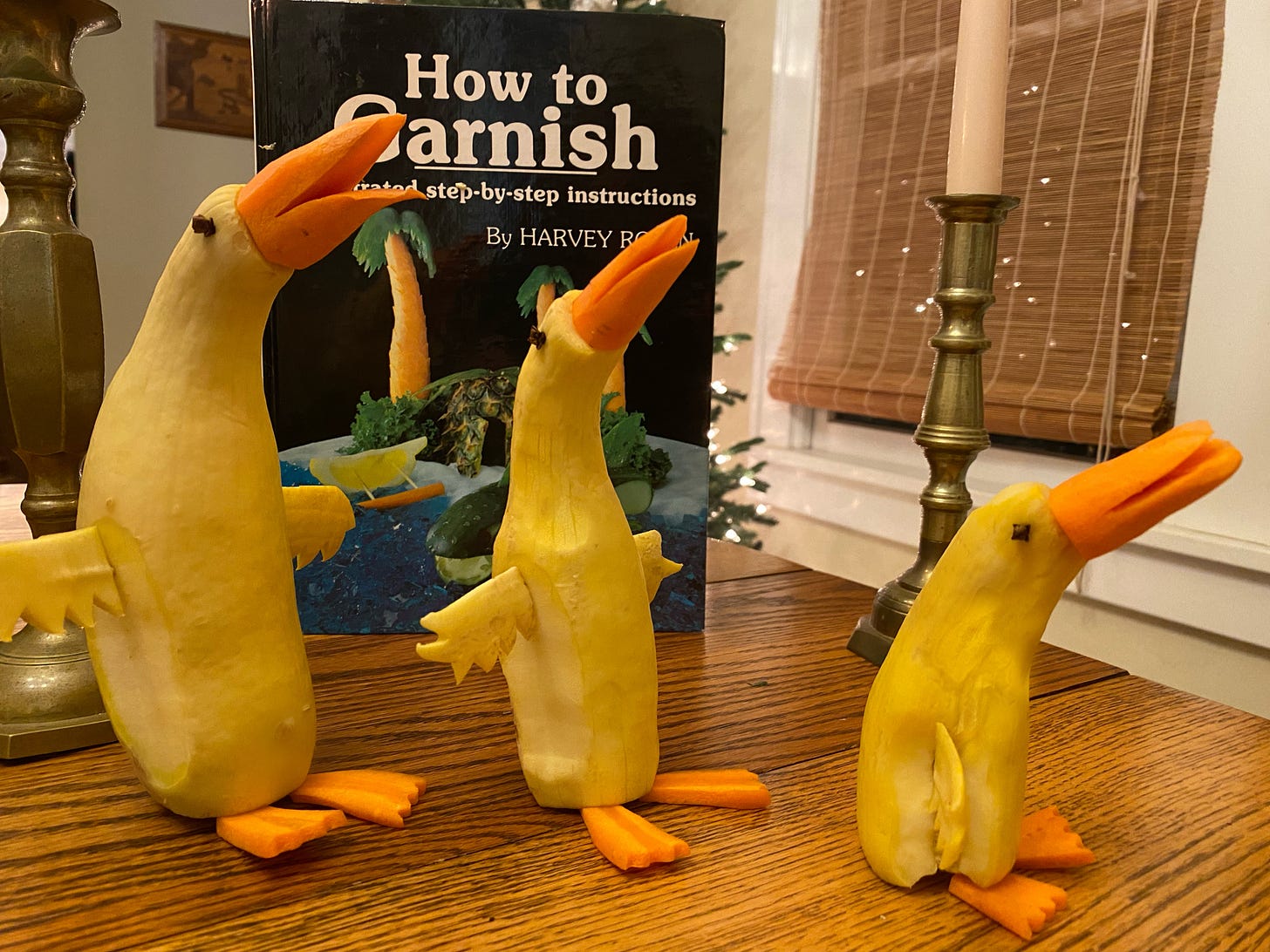How to Garnish
Instructions on making (and becoming) a Silly Goose
Last month, I acquired a tome of unspeakable power.
The book was How to Garnish by Harvey Rosen, a gleaming hardcover guide to the best edible garnishes known to mammal. These are not the twee botanical garnishes of your grocery-store deli case. Harvey’s only interested in heavy-hitters—a turnip mouse, a melon whale. I picked up the book because of its cover photo: a cucumber whittled into the shape of a shark, its body painted with liquid gelatin for that watery, just-beached sheen.
Mostly, I picked it up for an antidote to the joyless, avant-garde plating that’s defined our Boring ‘20s. No one wants to make cucumber sharks anymore. We’re horny for massive spoons that we can use to smear coulis into giant commas. Our parched vision of luxury is a fleet of squeeze bottles daubing multi-colored sauces into confetti pinpricks. We are living in the era of Very Small Food served on Very Large Rocks.
How to Garnish is both a practical guide to fine kitchen tools and a scrapbook of food trends of yore. My copy was published in 1983 by International Culinary Consultants—a publishing house so real, so selective, so elite, that it exclusively published books by Harvey Rosen. The back cover shows Harvey and three other garde mangers in double-breasted chef’s coats and crisp white toques, straight out of a recruitment pamphlet for Le Cordon Bleu.
It’s the kind of thing you could only get away with in the ‘80s, when homestyle kitsch didn’t feel quite so removed from haute cuisine. Homemakers pored over issues of Family Circle for holiday garnishes: reindeer celery sticks with pretzel antlers, witch-themed Halloween cupcakes with ice cream cone hats. Swanky chefs packed up leftovers in swan boats shaped from aluminum foil. Those feel like retro affectations now, but they share a common impulse: to delight, not necessarily to impress. To treat food as a vehicle for someone else’s joy.
I’d like to resurrect that ethos. I went to a Christmas party and brought a hostess gift—a cucumber shark in a Ziploc bag. A couple weeks later, I assembled a cheese plate for a friend and nestled a shark alongside. I’m going to link to a tutorial below for anyone else who wants to try one for their next sharkuterie board. It’s a relatively easy garnish that requires few specialty tools. All you really need is a paring knife.
But for me, the shark was a gateway drug, not a destination. I had set my sights on something much more involved. I discussed it with friends in the hushed, reverent tones of a golf announcer. I was preparing, I told, them, for the Olympic Games of garnishing. I was preparing to tackle the Silly Goose.
The Silly Goose, like many of Rosen’s garnishes, is a showpiece—more art than accent. It is technically edible, but that’s beside the point. No one’s biting into a raw yellow squash.
Crucially, the goose is also meant to be part of a tableau. Harvey does not want you to rest on your laurels, content with a single goose. Your guests deserve a flock.
The goose is deceptively simple. You really only need three ingredients: a curvy-necked yellow squash for the body, carrots for the feet and beak, and cloves for its beady little eyes. I formed the goose’s webbed toes with a crinkle cutter—one of a few tools Rosen insists you acquire if you want to take your garnishing seriously. Longtime readers will know that I needed no convincing. I cherish my crinkle cutter, an heirloom I have previously referred to in these annals as a “funhouse guillotine.”
I assembled my garnishes in a fugue state, gripped by Michelangelan agony and ecstasy. When I was done, I had assembled three geese, each alike in indignity. They wilted on my dining room table for a few days before Christmas, looking for all the world like a goose-themed nativity.
The longer they sat, the more their carrot beaks curled open—which is to say, the geese became even sillier with time.
I aspire to the same. Harvey’s garnishes are delightful to me because they’re so impractical. They’re not an integral part of a dish. They’re ersatz appendages. They exist only to be silly and beautiful, and they’re relics from a time when that existence was enough.
Exactly one week ago, there was a shooting at my old high school in Perry, Iowa—the high school where my dad (a retired band director and current auditorium manager) still works.
After the shooting, multiple friends reached out urging me to cancel plans and “take some time to myself.” I wasn’t entirely sure what they meant. For most of my life, people have been telling me to slow down. Last year, I traveled a lot in the wake of my divorce, and a well-meaning friend called me to gently inquire whether I might be experiencing a manic episode.
Both of those gestures were well intentioned, but they also reminded me that we need better narratives around grief. We conflate “moving” with “moving on”—the implication is that grief is an emotion we can only process fully by sitting alone in a dark room with our thoughts.
Of course, most of us don’t get the opportunity to sit alone in a dark room. We keep going; our thoughts go with us. That’s not a statement about resilience but about the practical necessity of growing around chaos like a crooked tree. Every day is a tragicomic exercise in emotional power clashing. We crack jokes in the hospital waiting room; we learn about a school shooting in the car on the way to a party, a cucumber shark balanced on one knee. I’m not sure what choice we have but to let emotion seep through our gills while we glide through dark oceans, menacing perpetual motion machines.
The joy doesn’t cover for the grief. They coexist. The joy is not a sufficient response to the evils of the world. Its utility is limited. But it might be a necessary complement to them—a garnish.
Haterade stickers are available!
You know the drill. They’re free to a bad home. Details here.
If you liked this post, please share, subscribe, or send to a friend! That’s how most people find the newsletter. And if you’d like to keep the newsletter coming, you can donate to the Haterade Foundation for Terminally Silly Geese here: Venmo | PayPal







Thank you for 'sharkuterie'
Me: ok, a shark is fun but I don't know that I'll... THESE GEESE ARE AMAZING. WHEN IS SUMMER?
My eldest daughter had an existential crisis yesterday coming to the realization that nothing we'll do will have a lasting impact, someday the whole planet will burn up, and we'll all be gone. We're just a blip in time and space. So she said, you might as well try to be a happy blip.